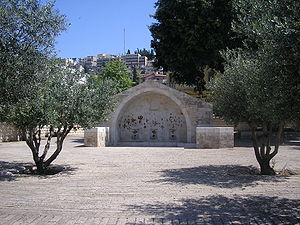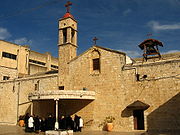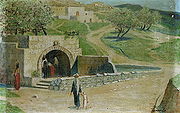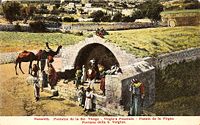
Mary's Well
Encyclopedia

Angel Gabriel
Angel Gabriel may refer to:*The Archangel Gabriel*The Angel Gabriel , an English galleon that sank off Pemaquid, Maine...
appeared to Mary and announced that she would bear the Son of God
Son of God
"Son of God" is a phrase which according to most Christian denominations, Trinitarian in belief, refers to the relationship between Jesus and God, specifically as "God the Son"...
- an event known as the Annunciation
Annunciation
The Annunciation, also referred to as the Annunciation to the Blessed Virgin Mary or Annunciation of the Lord, is the Christian celebration of the announcement by the angel Gabriel to Virgin Mary, that she would conceive and become the mother of Jesus the Son of God. Gabriel told Mary to name her...
.
Found just below the Greek Orthodox Church of the Annunciation
Greek Orthodox Church of the Annunciation
The Greek Orthodox Church of the Annunciation, also known as the Church of St. Gabriel or St. Gabriel's Greek Orthodox Church, is an Eastern Orthodox church in Nazareth, Israel...
in modern-day Nazareth
Nazareth
Nazareth is the largest city in the North District of Israel. Known as "the Arab capital of Israel," the population is made up predominantly of Palestinian Arab citizens of Israel...
, the well was positioned over an underground spring that served for centuries as a local watering hole for the Arab
Arab
Arab people, also known as Arabs , are a panethnicity primarily living in the Arab world, which is located in Western Asia and North Africa. They are identified as such on one or more of genealogical, linguistic, or cultural grounds, with tribal affiliations, and intra-tribal relationships playing...
villagers. Renovated twice, once in 1967 and once in 2000, the current structure is a symbolic representation of the structure that was once in use.
In the New Testament

Gospel
A gospel is an account, often written, that describes the life of Jesus of Nazareth. In a more general sense the term "gospel" may refer to the good news message of the New Testament. It is primarily used in reference to the four canonical gospels of Matthew, Mark, Luke, and John...
dating to the second century. The author writes:
"And she took the pitcher and went forth to draw water, and behold, a voice said: 'Hail Mary, full of grace, you are blessed among women.'"
However, neither the Gospel of Matthew
Gospel of Matthew
The Gospel According to Matthew is one of the four canonical gospels, one of the three synoptic gospels, and the first book of the New Testament. It tells of the life, ministry, death, and resurrection of Jesus of Nazareth...
, Gospel of Mark
Gospel of Mark
The Gospel According to Mark , commonly shortened to the Gospel of Mark or simply Mark, is the second book of the New Testament. This canonical account of the life of Jesus of Nazareth is one of the three synoptic gospels. It was thought to be an epitome, which accounts for its place as the second...
, Gospel of Luke
Gospel of Luke
The Gospel According to Luke , commonly shortened to the Gospel of Luke or simply Luke, is the third and longest of the four canonical Gospels. This synoptic gospel is an account of the life and ministry of Jesus of Nazareth. It details his story from the events of his birth to his Ascension.The...
nor the Gospel of John
Gospel of John
The Gospel According to John , commonly referred to as the Gospel of John or simply John, and often referred to in New Testament scholarship as the Fourth Gospel, is an account of the public ministry of Jesus...
mention the drawing of water in their accounts of the Annunciation. Similarly, the Koran records a spirit visiting a chaste Mary to inform her that the Lord has granted her a son to bear, without referencing the drawing of water.
Through history

Rosicrucian
Rosicrucianism is a philosophical secret society, said to have been founded in late medieval Germany by Christian Rosenkreuz. It holds a doctrine or theology "built on esoteric truths of the ancient past", which, "concealed from the average man, provide insight into nature, the physical universe...
Forum (1935), before the Christian era, it was known as the "spring of the guard house", so named because the few houses located by it at the time housed a number of local guards who patrolled an important highway that passed by the well. In his book, The Bible as History, Werner Keller writes that "Mary's Well" or "Ain Maryam", as the locals called it, had been so named since "time immemorial" and that it provided the only water supply in the area. William Rae Wilson also describes "a well of the Virgin, which supplied the inhabitants of Nazareth with water" in his book, Travels in Egypt and the Holy Land (1824).
James Finn
James Finn
James Finn was a British Consul in Jerusalem, in the then Ottoman Empire . He arrived in 1845 with his wife Elizabeth Anne Finn. Finn was a devout Christian, who belonged to the London Society for Promoting Christianity Amongst the Jews, but who did not engage in missionary work during his years in...
, then British
United Kingdom of Great Britain and Ireland
The United Kingdom of Great Britain and Ireland was the formal name of the United Kingdom during the period when what is now the Republic of Ireland formed a part of it....
Consul
Consul (representative)
The political title Consul is used for the official representatives of the government of one state in the territory of another, normally acting to assist and protect the citizens of the consul's own country, and to facilitate trade and friendship between the peoples of the two countries...
in Jerusalem, visited Nazareth in late June 1853 and his company pitched their tents near the fountain, - the only fountain there. He writes that "the water at this spring was very deficient this summer season, yielding only a petty trickling to the anxious inhabitants. All night long the women were there with their jars, chattering, laughing, or scolding in competition for their turns. [ ] It suggested a strange current of ideas to overhear pert damsels using the name of Miriam (Mary), in jest and laughter at the fountain of Nazareth"


Byzantine
Byzantine usually refers to the Roman Empire during the Middle Ages.Byzantine may also refer to:* A citizen of the Byzantine Empire, or native Greek during the Middle Ages...
era church built over the spring in 3CE, based on the belief that the Annunciation took place at the site. The Catholic Church believes the Annuciation to have take place less than 0.5km away at the Basilica of the Annunciation, a now modern structure which houses an older church inside of it that dates from 4CE.
Recent Archaeological Discoveries
Excavations by Yardenna Alexandre and Butrus Hanna of the Israel Antiquities AuthorityIsrael Antiquities Authority
The Israel Antiquities Authority is an independent Israeli governmental authority responsible for enforcing the 1978 Law of Antiquities. The IAA regulates excavation and conservation, and promotes research...
in 1997-98 - sponsored by the Nazareth Municipality and the Government Tourist Corporation - discovered a series of underground water systems and suggested that the site today known as Mary’s Well served as Nazareth's main water supply from as early as Byzantine
Byzantine
Byzantine usually refers to the Roman Empire during the Middle Ages.Byzantine may also refer to:* A citizen of the Byzantine Empire, or native Greek during the Middle Ages...
times. Despite having found Roman era potsherds, Alexandre's report claimed hard evidence of Roman-era use of the site was lacking.
Bathhouse
In the late 1990s, a local Nazareth couple, Elias and Martina Shama, were trying to discover the source of a water leak in their gift shop, Cactus, just in front of Mary’s Well. Digging through the wall, they discovered underground passages that, upon further digging revealed a vast underground complex. A North AmericanNorth American
North American generally refers to an entity, people, group, or attribute of North America, especially of the United States and Canada together.-Culture:*North American English, a collective term used to describe American English and Canadian English...
research team conducted high-resolution ground penetrating radar (GPR) surveys at a number of locations in and around Mary’s Well in 2004-5 to determine appropriate locations for further digging to be conducted beneath the bathhouse. Samples were collected for radio-carbon dating and the initial data from GPR readings seem to confirm the presence of additional subterranean structures.
In 2003, archaeologist Richard Freund stated his belief that the site was clearly of Roman-era
Ancient Rome
Ancient Rome was a thriving civilization that grew on the Italian Peninsula as early as the 8th century BC. Located along the Mediterranean Sea and centered on the city of Rome, it expanded to one of the largest empires in the ancient world....
origins: ""I am sure that what we have here is a bathhouse from the time of Jesus," he says, "and the consequences of that for archaeology, and for our knowledge of the life of Jesus, are enormous."
Carbon 14 dating was done on 3 samples of charcoal, each was found to come from a very different time period, indicating the bath house had been used in multiple periods, and at least was used sometime between 1300-1400, although with only 3 samples dated, it is possible for the bath house to be older.

